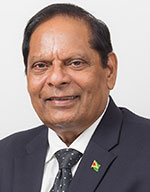SECTIONS of the media last week breathed a bit of fresh air with coverage of events involving our youth. This newspaper on Friday celebrated the launch of the Guyana Youth Corps with the banner headline, “Hope for Youths”. Yesterday, it front-paged a charge by President David Granger to the Regional Youth Caucus for our young people to “Help Create a Better Guyana”.
The non-government newspapers, however, remained locked down mainly on post no-confidence motion issues, which are now pending before the Caribbean Court of Justice (CCJ) – Guyana’s last and highest court of appeal. CCJ President, Hon. Justice Adrian Saunders has set May 10, 2019, as the date for hearing of these constitutional matters. Life goes on, in the meantime.
Stunned by the decision of the Guyana Court of Appeal that the motion was not carried, opposition elements have resorted to a campaign of disparaging our appellate judges for using “jumbie maths” to fix the absolute majority of 34 MPs that was required to pass a vote to effect the removal of a lawfully-elected government. Now, they have shifted the spectre of fraud with which they try to taint our Court of Appeal to a priori suspected bias on the part of the Caribbean Court of Justice.
PUTRID SMOKE
Someone not familiar with Guyana’s tit-for-tat politics, and the role of sections of the media in stoking the putrid smoke of discontent to hide positive stories might fall for this blitz of negativity. But the good stories cannot be hidden or buried.
Take, for example, the disclosure by Minister of Finance Winston Jordan that our economy grew last year by 4.1%, and is likely to grow further this year. This, ordinarily, would be celebrated as a giant leap over the clouds of political uncertainty which the opposition no-confidence motion had intended to trigger, but the media detractors would bury this story.
Another example of the good news is the positive drive under a government-private sector partnership to provide housing solutions for our people. There are, at one location, separate housing units up for sale for prices as low as $4 million (just above US$20,000), and many young families hope, finally, to own a home.
The dire need of our young people for housing solutions was dramatized at the recent Government Outreach at the Square of the Revolution. I noted the many persons who were walking around with pieces of paper in their hands, that they have been promised house lots several years ago. Those promises by the former regime have never materialized.
DREAM HOMES
Almost 30,000 persons are known to have abandoned their house lots, as they had no money to build their own homes. So, the Coalition Government decided to partner with private builders in providing low-cost housing units, and apartment-type duplexes. There may not be enough of these for everyone in need, but the government has moved from the empty promises of the past to facilitate personal possession of dream homes.
The Meet the People “mobile government” exercises stirred new energy in both government and the public. It allowed re-connection between government and people, and re-activation of full confidence from the grassroots.
An important segment of the “roots” are our youth who, in recent days, have featured in several events, including the launching of the Guyana Youth Corps under which some 1,000 young people from across the country will be trained and will be assisted to find gainful, sustainable employment.
At that event at the Kuru Kuru residential training complex, President Granger remarked:
“Young people are this country’s future; it cannot be otherwise. It is the older generation’s obligation to ensure that the young population receives the best possible preparation to inherit this nation…This country will falter if its youth flounders; it will remain poor and underdeveloped as long as its youth remain undeveloped.”
HOPE AND HAPPINESS
The President pointed to greater opportunities for youth in the petroleum sector and in a diversified economy. “Young people today,” he added, “face a future of hope and happiness.”
He went on to describe our youth as our main resource, our richest resource, with half of our people being below the age of 24. However, the statistics on youth employment have been dismal. Between 2007 and 2017, more than 20% of our youth did not find jobs. The situation is compounded as some 12,500 students leave secondary schools each year, and are either looking towards higher education or seeking jobs.
Some new opportunities for our youth have been opened with the establishment of regional radio stations which have enlisted a corps of young broadcasters from hinterland communities. They are meeting in Georgetown over the weekend to familiarize themselves with the Guyana Constitution, Amerindian Act and a Code for ethical and professional broadcasting.
GENTLE REVOLUTION
Giving the enthusiastic new broadcasters and technical monitors a pep talk yesterday, I noted that Guyana has been undergoing a silent, gentle revolution in promoting communication to and among our people. Several hinterland communities now enjoy access to internet and to public radio communication.
After launching the UN Year of Indigenous Peoples Languages, Guyana has proudly initiated broadcast in local languages.
I am very pleased that President Granger has given full and spirited support for this initiative for a public radio station in the capital of each region. In due course, this will include television signals to remote communities. The Office of the Prime Minister has started discussions for the use of the Guyana Learning Channel portals and satellite to take public television programmes to at least sixteen of these hinterland communities.
LEADERSHIP ROLES
It is very satisfying that I should be in public office to help the transition of our young people to leadership roles in our society. I belong to that generation that had great hopes but enjoyed very little happiness, after joining in 1961 what was a barefooted Berbice brigade for political independence of our country from Great Britain.
Then we had very limited access to paid high school education, and it was a hassle to find productive or rewarding jobs. We struggled and sacrificed for small mercies. Many otherwise patriotic and talented youth migrated to what they had looked upon as greener pastures in the metropolis, and formed the Guyanese diaspora, almost in every country of the world.
Today, our youth are on the rebound. They can count on encouragement and support from a government that understands their plight and is ready to work with them and for them, in order to build a future that holds hope with happiness.




.png)









